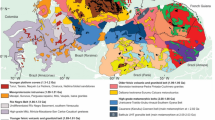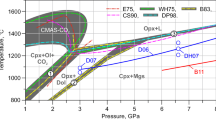Abstract
Clinopyroxene is an essential mineral in eclogitic rocks. It commonly contains minor amounts of the defect-bearing Ca-Eskola (CaEs, Ca0.5□0.5AlSi2O6) component, with higher concentrations generally considered to indicate a high-pressure origin at least within the coesite stability field. Changes in pressure and temperature conditions can lead to exsolution of this component as a free SiO2 phase, which may have a number of petrological implications. This makes it important to understand the factors that maximize CaEs incorporation in clinopyroxene. We have undertaken a series of experiments at high pressures and temperatures (4–10 GPa and 1000–1350 °C) to further investigate the systematics of CaEs incorporation in eclogite-like clinopyroxene and the factors responsible for maximizing CaEs contents. Two simple chemical systems were chosen that allow unambiguous interpretation of the results: (1) CMAS + H2O and (2) two compositions in the NCMAS system. All experimental products contained clinopyroxene and garnet along with either a free SiO2 phase or a silicate melt. Coexisting garnet is grossular-rich, generally with X gr ≥ 0.67. Compositional variations are attributable to the presence or absence of melt and changes in modal amounts of garnet at different pressure–temperature conditions. Even small amounts of H2O lower the solidus temperature and the presence of a melt reduces the SiO2 activity, which destabilizes the CaEs component in clinopyroxene. The CaEs and the Ca-Tschermaks (CaTs, CaAl2SiO6) components in clinopyroxene decrease with increasing jadeite mole fraction, which is also a function of pressure and bulk Al content. Modeling X-ray powder diffraction data yields a molar volume for the CaEs endmember of V CaEs = 60.87(63) cm3, which reasonably agrees with a literature value that was estimated from natural samples. In the presence of coexisting coesite, the CaEs and CaTs do not vary independently of each other, being controlled by the internal equilibrium 2CaEs = CaTs + 3SiO2 (coesite). This relation, observed in simple systems (i.e., CMAS ± Na), is also obeyed by clinopyroxene in more complex, natural analog bulk compositions. An assessment of available experimental data reveals a maximum of 15–18 mol% CaEs in eclogitic clinopyroxene at conditions corresponding to 130–180 km depth. CaEs contents are maximized at high temperatures; i.e., at or near the solidus in the presence of coesite. Thus, this study supports the role of CaEs exsolution in contributing to melt generation during upwelling of eclogite bodies in the mantle, albeit with some caveats. Somewhat higher maximum CaEs contents (~20 mol%) are found in Ca and Al-rich bulk compositions, such as grospydite xenoliths. Such bulk compositions also seem to require the coexistence of kyanite. Other Ca and Al-rich rock types, like rodingites, should have the potential of containing CaEs-rich clinopyroxenes, except that they are SiO2-undersaturated. This emphasizes the further role of bulk composition, in addition to high temperatures, in achieving maximum CaEs contents in high-pressure clinopyroxene.








Similar content being viewed by others
References
Bishop FC, Smith JV, Dawson JB (1976) Na, P, Ti and coordination of Si in garnet from peridotite and eclogite xenoliths. Nature 260:696–697
Brey GP, Nickel KG, Weber R (1990) Calibration of belt apparatus to 1800 ℃ and 6 GPa. J Geophys Res 95(B10):15603–15610
Brey GP, Bulatov VK, Girnis AV, Lahaye Y (2008) Experimental melting of carbonated peridotite at 6–10 GPa. J Petrol 49:797–821
Coleman RG, Lee DE, Beatty LB, Brannock WW (1965) Eclogites and eclogites: their differences and similarities. Geol Soc Am Bull 76:483–508
Ellis DJ, Green DH (1979) An experimental study of the effect of Ca upon garnet-clinopyroxene Fe–Mg Exchange Equilibria. Contrib Mineral Petrol 71:13–22
Etzel K, Benisek A, Dachs D, Cemic L (2007) Thermodynamic mixing behavior of synthetic Ca-Tschermak–diopside pyroxene solid solutions: I. Volume and heat capacity of mixing. Phys Chem Miner 34:733–746
Ganguly I, Weiji C, O’Neill HSC (1993) Syntheses, volume, and structural changes of garnets in the pyrope-grossular join: implications for stability and mixing properties. Am Mineral 78:583–593
Gasparik T (1986) Experimental study of subsolidus phase relations and mixing properties of clinopyroxene in the silica-saturated system CaO–MgO–Al2O3–SiO2. Am Mineral 71:686–693
Gasparik T (2002) Experimental investigations of the origin of majoritic garnet inclusions in diamonds. Phys Chem Miner 29:170–180
Holland TJ, Powell R (2011) An improved and extended internally consistent thermodynamic dataset for phases of petrological interest, involving a new equation of state for solids. J Metamorph Geol 29:333–383
Irifune T, Sekine T, Ringwood AE, Hibberson WO (1986) The eclogite-garnetite transformation at high pressure and some geophysical implications. Earth Planet Sci Lett 77:245–256
Jerde EA, Taylor LA, Crozaz G, Sobolev NV (1993) Diamondiferous eclogites from Yakutia, Siberia: evidence for a diversity of protolith. Contrib Mineral Petrol 114:189–202
Katayama I, Nakashima S (2003) Hydroxyl in clinopyroxene from the deep subducted crust: evidence for H2O transport into the mantle. Am Mineral 88:229–234
Katayama I, Parkinson CD, Okamoto K, Nakajima Y, Maruyama S (2000) Supersilicic clinipyroxene and silica exsolution in UHPM eclogite and pelitic gneiss from the Kokchetav massif, Kazakhstan. Am Mineral 85:1368–1374
Klimm K, Blundy JD, Green JT (2008) Trace element partitioning and accessory phase saturation during H2O-saturated malting of basal with implications for subduction zone chemical fluxes. J Petrol 3:523–553
Knapp N, Woodland AB, Klimm K (2013) Experimental constrains in the CMAS system on the Ca-Eskola content of eclogitic clinopyroxene. Eur J Mineral 25:579–596
Knapp N, Woodland AB, Klimm K (2015) Experimental constraints on coesite abundance in eclogite and implication for the seismic discontinuity. J Geophys Res Solid Earth 120:4917–4930
Konzett J, Frost DJ, Proyer A, Ulmer P (2008) The Ca-Eskola component in eclogitic clinopyroxene as a function of pressure, temperature and bulk composition. An experimental study to 15 GPa with possible implication for the formation of oriented SiO2-inclusions in omphacite. Contrib Mineral Petrol 155:215–228
Lappin MR (1978) The evolution of a grospydite from the Roberts Victor Mine, South Africa. Contrib Mineral Petrol 66:221–241
Lappin MR, Dawson JB (1975) Two Roberts Victor cumulate eclogites and their reequilibrium. Phys Chem Earth 9:351–365
Larson AC, von Dreele RB (1988) GSAS manual Los Alamos National Laboratory, report LAUR, pp 86–748
Manning CE (1998) Fluid composition at the blueschist-eclogite transition in the model system Na2O–MgO–Al2O3–SiO2–H2O–HCl. Schweiz Mineral Petrogr Mitt 78:225–242
McCormick TC (1986) Crystal-chemical aspects of non-stoichiometric pyroxenes. Am Mineral 71:1434–1440
Morishita T, Arai S, Green DH (2004) Possible non-melted remnants of subducted lithosphere: experimental and geochemical evidence from corundum-bearing mafic rocks in the Horoman peridotite complex. J Petrol 45:235–252
Novella D, Frost DJ, Hauri EH, Bureau H, Raepsaet C, Roberge M (2014) The distribution of H2O between silicate melt and nominally anhydrous peridotite and the onset of hydrous melting in the deep upper mantle. Earth Planet Sci Lett 400:1–13
Page FZ, Essene EJ, Musaka SB (2005) Quartz exsolution in clinopyroxene is not a proof of ultrahigh pressures: evidence from eclogites from Eastern Blue Ridge, Southern Appalachians, USA. Am Mineral 90:1092–1099
Perchuk AL, Yapaskurt VO (2013) Experimental simulation of orthopyroxene enrichment and carbanation in the suprasubduction mantle under the influence of H2O, CO2, and SiO2. Geochem Int 51:257–268
Pertermann M, Hirschmann MM (2003) Anhydrous partial melting experiments on a MORB-like eclogite: phase relations, phase compositions and mineral/melt partitioning of major elements at 2–3 GPa. J Petrol 44:2173–2201
Proyer A, Krenn K, Hoinkes G (2009) Oriented precipitates of quartz and amphibole in clinopyroxene of metabasites from Greek Rhodope: a product of open system precipitation during eclogite-granulite-amphibolite transition. J metamorphic Geol 27:639–654
Rice JM (1983) Metamorphism of rodingites: part I. Phase relations in a portion of the system CaO–MgO–Al2O3–SiO2–CO2–H2O. Am J Sci 283A:121–150
Rosenthal A, Yaxley GM, Green DH, Hermann J, Kovacs I, Spandler C (2014) Continuous eclogite melting and variable refertilisation in upwelling heterogenous mantle. Sci Rep 4:6099. doi:10.1038/srep06099
Rosenthal A, Hauri EH, Hirschmann MM (2015) Experimental determination of C, F, and H partitioning between mantle minerals and carbonated basalt, CO2/Ba and CO2/Nb systematics of partial melting, and the CO2 contents of basaltic source regions. Earth Planet Sci Lett 412:77–87
Schandl ES, O’Hanley DS, Wicks FJ (1989) Rodingites in serpentinized ultramafic rocks of the Abitibi greenstone belt, Ontario. Can Mineral 27:579–591
Shu Q, Brey G, Hoefer H, Zhao Z, Pearson G (2016) Kyanite/corundum eclogites from the Kaapvaal Craton: subducted troctolites and layered gabbros from the Mid- to Early Archean. Contrib Mineral Petrol 171:11
Smyth JR (1980) Cation vacancies and the crystal chemistry of breakdown reactions in kimberitic omphacites. Am Mineral 65:1185–1191
Smyth JR, Bell DR, Rossmann GR (1991) Incorporation of hydroxyl in upper-mantle clinopyroxenes. Nature 352:732–735
Sobolev NV, Kuznetsova IK, Zyuzin NI (1968) The petrology of grospydite xenoliths from the Zagadochnaya kimberlite pipe in Yakutia. J Petrol 9:253–280
Spandler C, Yaxley G, Green DH, Rosenthal A (2008) Phase relations and melting of anhydrous K-bearing eclogite from 1200 to 1600 °C and 3 to 5 GPa. J Petrol 49:771–795
Toby BH (2001) EXPGUI, a graphical user interface for GSAS. J Appl Crystallogr 34:1017–1031
Viljoen KS, Schulze DJ, Quadling G (2005) Contrasting group I and group II eclogite xenolith petrogenesis: petrological, trace element and isotopic evidence from eclogite, garnet-websterite and alkremite xenoliths in the Kaalvallei kimberlite, South Africa. J Petrol 46:2059–2090
Williams Q, Revenaugh J (2005) Ancient subduction, mantle eclogite, and the 300 km seismic discontinuity. Geology 33:1–4
Wood BJ, Henderson CMD (1978) Compositions and unit-cell parameters of synthetic non-stoichiometric tschermakitic clinopyroxene. Am Mineral 63:66–72
Wood BJ, Holland TJB, Newton RC, Kleppa OJ (1980) Thermochemistry of jadeite-diopside pyroxenes. Geochem Cosmochem Acta 44:1363–1371
Yagi T, Akaogi M, Shimomura O, Suzuki T, Akimoto S (1987) In situ observation of the olivine-spinel phase transformation in Fe2siO4 using synchrotron radiation. J Geophys Res 92(B7):6207–6213
Zhang J, Li B, Utsumi W, Liebermann RC (1996) In-situ X-ray observations of the coesite–stishovite transition: reversed phase boundary and kinetics. Phys Chem Miner 23:1–10
Zhang J, Ellis DJ, Jiang WB (2003) Ultrahigh-pressure metamorphism in western Tianshan, China: part I. Evidence from inclusions of coesite pseudomorphs in garnet and from quartz exsolution lamellae in omphacite in eclogites. Am Mineral 87:853–860
Zhang J, Song S, Liou JG, Ai Y, Li X (2005) Relict coesite exsolution in omphacite from Western Tianshan eclogites, China. Am Mineral 90:181–186
Zhao S, Nee P, Green HW, Dobrzhinetskaya LF (2011) Ca-Eskola component in clinopyroxene: experimental studies at high pressures and high temperatures in multianvil apparatus. Earth Planet Sci Lett 307:517–524
Acknowledgements
This work was supported by Deutsche Forschungsgemeinschaft Grant Wo652/16-1 to ABW. Vadim Bulatov, Andrei Girnis, Thomas Kautz are thanked for their help and advice in the high-pressure lab. The authors thank Heidi Höfer for help with the microprobe and Nils Prawitz for the preparation of samples. Our work has benefitted through fruitful discussions with Gerhard Brey.
Author information
Authors and Affiliations
Corresponding author
Additional information
Communicated by Jochen Hoefs.
Rights and permissions
About this article
Cite this article
Schroeder-Frerkes, F., Woodland, A.B., Uenver-Thiele, L. et al. Ca-Eskola incorporation in clinopyroxene: limitations and petrological implications for eclogites and related rocks. Contrib Mineral Petrol 171, 101 (2016). https://doi.org/10.1007/s00410-016-1311-3
Received:
Accepted:
Published:
DOI: https://doi.org/10.1007/s00410-016-1311-3




